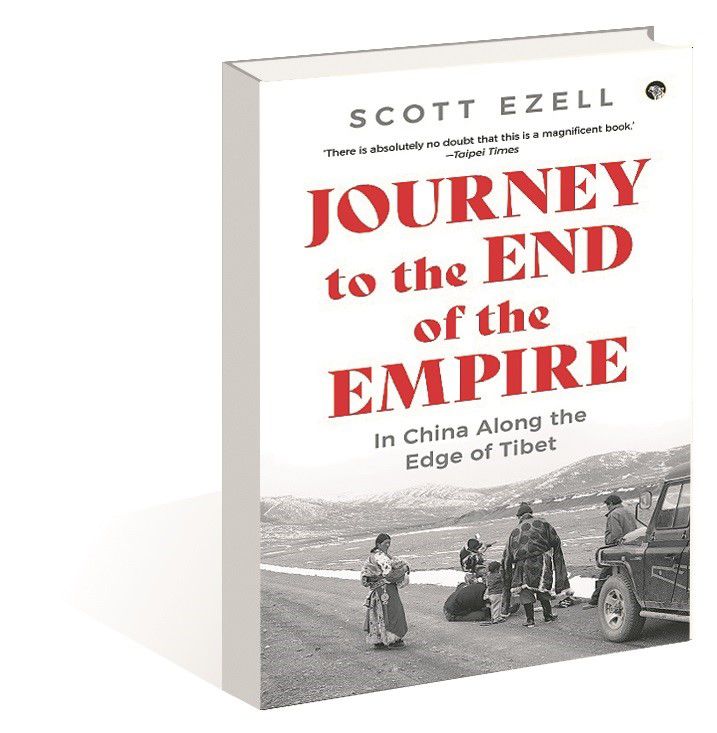Journey to the End of the Empire: In China Along the Edge of Tibet by Scott Ezell. Speaking Tiger. Pages 284. Rs 499
Book Title: Journey to the End of the Empire: In China Along the Edge of Tibet
Author: Scott Ezell
Claude Arpi
The book under review is more than a fascinating travelogue. The author, Scott Ezell, is an American poet, musician and artist who has lived most of his life with indigenous people in Asia; first in Taiwan from 1992 to 2004, and then in mainland China and later, in India and Japan. He spent years documenting the effects of centralised state power, civil conflict and destructive resource extraction on marginalised communities.
His good knowledge of Mandarin makes the reading of his encounters on the Tibetan plateau richer and revealing.
His first experience of the Himalayas dates back to 1995; from Srinagar, he caught a bus to Leh, crossed the Zoji La and after a night in Kargil, arrived in Ladakh: “a western extension of the Tibetan plateau, a raw, arid plain at 3,500 metres that seemed to overflow with light. The earth unfurled like hammered gold, snow-capped mountains rose in the distance.”
There, he spent weeks hitchhiking around “in kerosene tanker trucks driven by Tibetan men whose cabs were festooned with Buddhist charms, icons, and mantras, as well as photos of the Dalai Lama, which they invariably pointed out with a reverent bow”.
In 2004, he paid his first visit to eastern Tibet, also known as the Tibetan Marches (a term used by the British to describe areas between China and central Tibet), today living under a foreign rule (that of Beijing).
In the former provinces of Kham and Amdo, along the edges of eastern Tibet, bordering mainland China, Ezell encountered the same elemental beauty that he had experienced in Ladakh, but without the religious freedom.
The author does not use the word ‘China’ for the Middle Kingdom; he instead refers to it as ‘the empire’. He explains: “This is not intended to diminish the importance of Tibet’s historical relationship with China… Rather, it is a means to emphasise the imposition of centralised state authority upon marginalised peoples.”
This vividly comes out on every page of his account: the Tibetan refugees in Ladakh or living in the ‘empire’, remain the same race, but with the difference that, in the latter, the people are unable to display their faith, for example, by hanging prayer flags in their courtyard.
The fact that he spoke Mandarin allowed Ezell to communicate with villagers, lamas or nomads; in other words, with ordinary people. On reaching the edge of Tibet, he writes: “After six weeks and 1,200 miles, I reached Kekexili, a wilderness reserve 17,000 feet above sea level. From there I crossed the Kunlun Mountains and descended to Golmud.”
It is where the Chinese empire starts.
This reminds me of the well-known 2004 film ‘Kekexili: Mountain Patrol’, which depicts not only the struggle between vigilante rangers and bands of poachers on China’s frontiers, but also the people’s harsh way of life as well as the rugged and majestic landscapes.
What is perhaps missing in Ezell’s account is the historical background on these areas, which witnessed the arrival of the warlords’ armies of Sichuan and Qinghai at the beginning of the 20th century, then Mao Zedong’s ‘Long March’ in the 1930s and finally the Communist ‘Liberation Army’ in the mid-1950s.
Lithang is one of these historical places. During a visit to the monastery in Lithang, Ezell recounts that while “the sun was low in the sky and the cold was settling in… The lama led us through the shrines of earthen Buddhas and wood carvings, butter lamps in smoky altars. Dolma [a Tibetan girl guiding the author] mumbled prayers all along the way, surprising me with her piousness”.
Lithang is not only the birthplace of the Seventh Dalai Lama (the Sixth Dalai Lama, born in Tawang, wrote the famous poem, “White crane lend me your wings. I will not fly far. From Lithang I shall return”), but also the spot of the horrific bombing of the monastery by the Communist Air Force in October 1956; the proud local khampa chieftains had dared to refuse to kowtow to Mao’s troops. A newspaper in Kalimpong had then reported: “They are killing several thousand of our freedom-loving, brave, ill-armed khampas, with modern weapons; and destroying monasteries. But alas! There is no voice for Tibet.”
In Yunnan, at the beginning of his journey, Ezell came across graffiti on a police station — Qingxie, xiejiao, ni, which he translated as “canted, beveled, you”. He felt that it was a strange juxtaposition, especially on a police station wall, but concluded: “Fuck the Police or Free Tibet I could understand; they were slogans of blunt dissent… compact and unambiguous. But, they’re going to cant and bevel you? …It was subversive at a whole different level.”
And everywhere in these Tibetan areas, he was struck by “a conspicuous absence of any sign, mention, or photo of the Dalai Lama, whether among truck drivers, in temples, or in household shrines”.
This is occupied Tibet.














